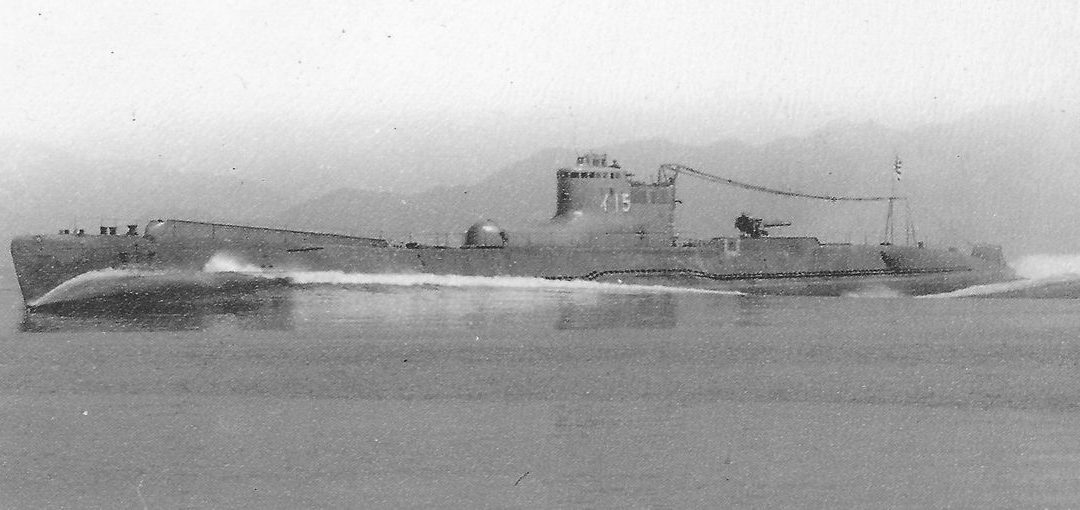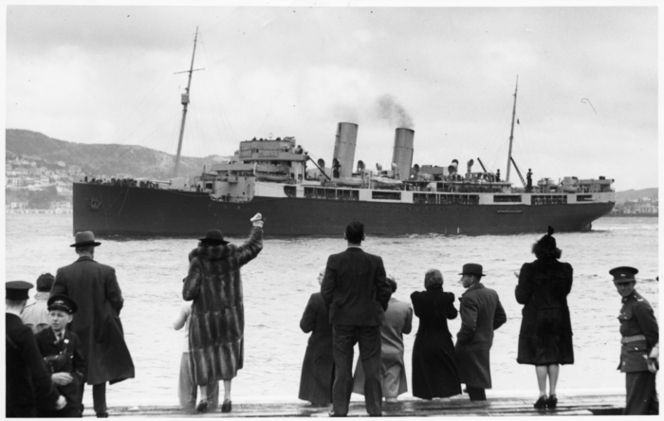During the Second World War, Japan conducted a small but significant submarine campaign into the Pacific and Indian oceans, ultimately ranging as far as the west coast of the United States and the South Pacific. First to reach the South Pacific was the 2,550 ton Type C1 class submarine I-20, under Lieutenant-Commander T. Yamada. She was among the ‘mother ships’ tasked with carrying five midget submarines to supplement the planned air raid on the US Pacific Fleet in Pearl Harbor.[1] In the event, I-20’s midget was sunk by USS Ward shortly before the air raids began. But it was only the beginning of I-20’s war.
By mid-January 1942, just five weeks after the mission to Pearl Harbor, Yamada and his crew were off Fiji, looking for targets. Here, late in the afternoon on 16 January, they found two ships departing Suva and attacked them with torpedoes. When the torpedoes exploded prematurely, Yamada surfaced to engage them with his 14-cm deck gun.[1]
On the face of it the two ships looked easy targets. In fact, the lead ship was the New Zealand auxiliary cruiser HMNZS Monowai, a former P&O steamer of about 10,800 gross tons that had been requisitioned in 1939 and, after some delays, commissioned for war service in 1940. Her military fit included eight 6-inch guns, two 3-inch AA, six 20-mm cannons, and eight depth charges; although she was, of course, unarmoured and built to mercantile standards.[2]
On outbreak of war in the Pacific, Monowai was sent north to the Marshall Islands, where New Zealand civilians of the Post and Telegraph Department were manning a coast-watch service and radio interception station, feeding intelligence to the United States. By mid-January 1942 she was at Fiji where she was ordered to escort the 4,325 gross ton passenger ship Taroona back to Auckland, after Taroona dropped off reinforcements for 8 New Zealand Brigade.
These were the ships found by Yamada. They were about to begin zig-zagging as an anti-submarine precaution when they were alerted to the Japanese attack by the torpedo misfires. Captain G. R. Deverell ordered Monowai to action stations and began snaking, while lookouts searched for what was thought to be an aircraft. Lieutenant-Commander S. W. Hicks recalled how the explosions were a surprise, but that a report of a conning tower came in quickly.[2] The Japanese boat was perhaps 7,500 yards distant. Deverell ordered the six- and three-inch guns to open fire, then a change of course to comb any torpedo tracks. As a result the guns only fired a few rounds before they could no longer bear, although Monowai straddled the submarine and Deverell saw ‘two shorts that appeared to be very close.’[3]
Deverell’s manoeuvre did not go down well with his gunlayers. Hicks recalled hearing the gunnery officer screaming for the captain to turn the ship and reopen the firing arcs.[4] The submarine returned fire with its deck gun and sent five rounds at the New Zealand vessel before crash-diving. Monowai turned again, firing 11 rounds of 6-inch and twelve of 3-inch at the submarine as it disappeared. The shooting was excellent, Hicks recalled later, given the fact that spotting was entirely visual.[5] There was one casualty; Ordinary Seaman Leslie Coombes suffered a burned arm from flash when one of the guns misfired.
Deverell ordered Taroona through the Mbennga passage, leading the way with Monowai. Hicks recalled navigating officer G. H. Edwards’ dismay at the request, but Edwards got them through at a speed of about 16 knots. Deverell later praised his navigator and added that Monowai’s engines ‘rose to the occasion excellently and in spite of leaky boilers and condensers, and defective turbo-generators, a speed of 95 revolutions (nominally 18.1 knots) was quickly reached.’[6] Once clear of the passage Deverell shaped course for Auckland.[7]
There were two sequels to the incident. Deverell was critical of his guns; they were manually trained, and the cranks demanded 110 lb force to turn them when the mounting was level. When listing under helm or in a seaway they were difficult or impossible to move. Nor were the firing arcs satisfactory. But on the plus side, he felt the 3-inch armament ‘if properly used’ could be a ‘valuable anti-submarine weapon because of its high rate of fire.’[8]
The New Zealand Naval Board were less impressed with Deverell. He had signalled Taroona in plain language, with the result that news of the incident was picked up by civilian listeners. ‘I understand the full story was generally known in Auckland last week, and now it appears to be common knowledge in Wellington,’ the Naval Intelligence Officer minuted ‘As the original sighting was signalled in plain language so that ships and w/t stations would hear and understand it, this seems almost inevitable.’[9] Deverell was hauled over the coals for not following proper military procedure. ‘HMNZS Monowai being a man of war,’ the Board wrote acidly, ‘should adhere to the codes and cyphers used in enemy reporting…Warning to merchant ships in the immediate vicinity should be by Mersigs, by w/t flashing or flag signal as appropriate. A general warning or diversion to merchant ships is the responsibility of the appropriate shore authority.’[10]
The incident marked the first blood of the Pacific war in the South Pacific. It was not the last. Other Japanese submarines ranged south during the next few months – in small numbers – including I-29, which entered Cook Strait in February, apparently looking for troop transports. The submarine then surfaced and launched its small float plane, flown by Fujita Nobuo, reconnoitring Port Nicholson and finding ‘four or five merchants’ in harbour. They then found one of the inter-island ferries connecting New Zealand’s North and South Islands, but had been forbidden to attack civilian shipping.
I-25 arrived in the South Pacific during March, encountering the armed merchant Tongariro. The Japanese boat went on to Cook Strait and made a further reconnaissance flight over the capital, then coasted north to the Hauraki Gulf apparently unseen — though the minesweeper HMNZS Viti reported a dubious hydrophone detection.
I-21 made a similar sortie into New Zealand waters in May. The boat surfaced off Mayor Island in the Bay of Plenty, and Lieutenant Isumo Ito took a floatplane across the Hauraki Gulf. Low cloud and rain hampered his effort, but he ‘circled Auckland at about 1200 feet and observed some small boats which he thought were fishing craft lying in the harbour.’ The submarine was meant to then scout Wellington waters and Port Nicholson, but news came that a simultaneous midget submarine attack into Sydney harbour had essentially failed, and the mission was abandoned.[11]
The ease with which Japan could operate submarines off New Zealand’s coastline was a telling indictment of New Zealand’s vulnerability at the time. Defence policy during the inter-war period had rested on supporting the British naval base at Singapore; by early 1942 that had failed, and now the government faced an uphill battle trying to procure aircraft and equipment to bolster local defence, at a time when all came via British sources, including any US material provided through lend-lease. Britain was stretched, and the correspondence between New Zealand Prime Minister Peter Fraser, and the British Prime Minister, Winston Churchill, is salutary evidence of the difference of view. In the end, Fraser sent a minister directly to Washington – against British objection – to negotiate support.
The attack on Sydney prompted precautions against similar raids into New Zealand harbours. Blackout extended to coastal street-lights and towns. One newspaper commented on the ‘Stygian gloom’ that followed.[12] There were more reports of submarines in New Zealand waters during June, and although the Solomons campaign of late 1942 diverted Japanese attentions there, the I-boats were back in the Tasman by early 1943. One passed through Cook Strait in February.[13] A small force of Fairmile launches, built in Auckland, entered service in the anti-submarine role. But by this time the tides of war were receding; Japan’s focus was elsewhere, and the next major submarine incursion into New Zealand waters was not Japanese, but German. That is covered in a separate article.
For more, check out Pacific War: New Zealand and Japan 1941-45, available from Amazon.
Copyright © Matthew Wright 2019
[1] http://www.combinedfleet.com/I-20.htm
[2] http://www.nzmaritime.co.nz/monowai/monowai.htm
[1] Waters, p. 212.
[2] RNZN Museum Oral History, Lt. Cmdr S. W. Hicks RNZN (Rtd)
[3] NA Navy Department Series 1 Operations HMNZS Monowai Encounter with submarine and aircraft, January 1942. ‘Report of action between HMNZS Monowai and U-boat.’
[4] RNZN Oral History, Lieutenant-Commander S W Hicks, RNZN (Rtd).
[5] Ibid.
[6] NA Navy Department Series 1 Operations HMNZS Monowai Encounter with submarine and aircraft, January 1942. ‘Report of action between HMNZS Monowai and U-boat.’
[7] NA Navy Department Series 1 Operations HMNZS Monowai Encounter with submarine and aircraft, January 1942. ‘Report of action between HMNZS Monowai and U-boat.’
[8] Ibid.
[9] Op cit, I/O minute, n.d.
[10] Op cit, NZNB to CO Monowai 28/1/42.
[11] Southern Cross, 26 July 1949.
[12] Evening Post, 27 July 1942.
[13] Waters, p. 219.







Recent Comments